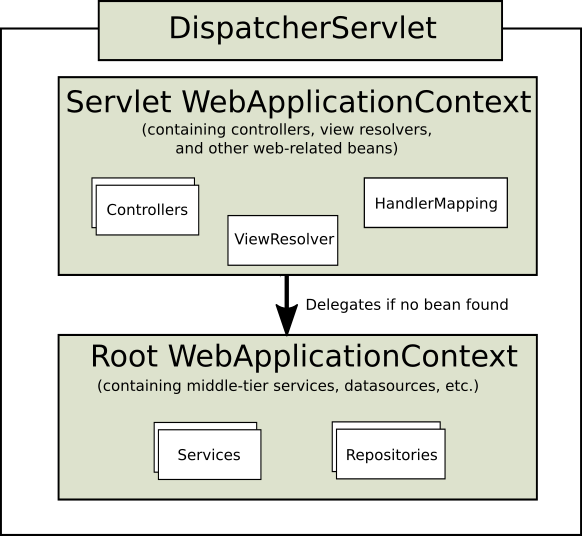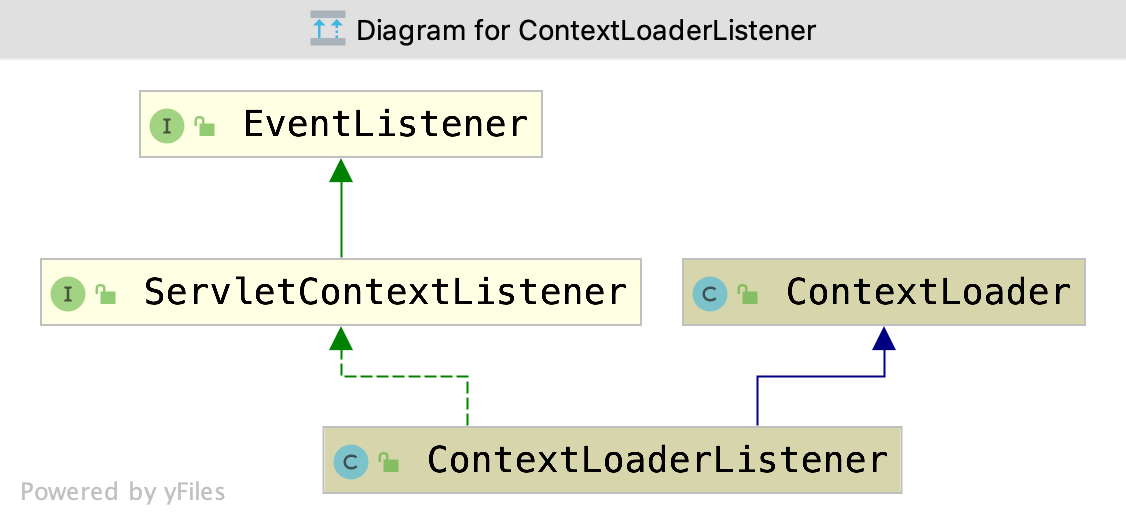Spring MVC源码——Root WebApplicationContext
Spring MVC源码——Root WebApplicationContext
打算开始读一些框架的源码,先拿 Spring MVC 练练手,欢迎点击这里访问我的源码注释, SpringMVC官方文档一开始就给出了这样的两段示例:
WebApplicationInitializer示例:
public class MyWebApplicationInitializer implements WebApplicationInitializer { @Override public void onStartup(ServletContext servletCxt) { // Load Spring web application configuration AnnotationConfigWebApplicationContext ac = new AnnotationConfigWebApplicationContext(); ac.register(AppConfig.class); ac.refresh(); // Create and register the DispatcherServlet DispatcherServlet servlet = new DispatcherServlet(ac); ServletRegistration.Dynamic registration = servletCxt.addServlet("app", servlet); registration.setLoadOnStartup(1); registration.addMapping("/app/*"); } }
web.xml 示例:
<web-app> <listener> <listener-class>org.springframework.web.context.ContextLoaderListener</listener-class> </listener> <context-param> <param-name>contextConfigLocation</param-name> <param-value>/WEB-INF/app-context.xml</param-value> </context-param> <servlet> <servlet-name>app</servlet-name> <servlet-class>org.springframework.web.servlet.DispatcherServlet</servlet-class> <init-param> <param-name>contextConfigLocation</param-name> <param-value></param-value> </init-param> <load-on-startup>1</load-on-startup> </servlet> <servlet-mapping> <servlet-name>app</servlet-name> <url-pattern>/app/*</url-pattern> </servlet-mapping> </web-app>
我们按照 web.xml 中的实例来看一下 Spring MVC 初始化过程.
上下文层次结构
Spring MVC 的上下文有如下这样的层级:

图中的 Servlet WebApplicationContext 是与 DispatcherServlet 绑定的上下文, 其中还有 controllers、ViewResolver、HandlerMapping 等组件.
Root WebApplicationContext 不是必须的上下文, 在需要时,可以用来在多个 DispatcherServlet 间共享一些 bean.
Root WebApplicationContext 初始化和销毁
ContextLoaderListener
web.xml 中配置的 ContextLoaderListener 用于启动和终止 Spring 的 root WebApplicationContext.

ContextLoaderListener
public class ContextLoaderListener extends ContextLoader implements ServletContextListener { public ContextLoaderListener() { } public ContextLoaderListener(WebApplicationContext context) { super(context); } /** * Initialize the root web application context. * Servlet 上下文初始化,调用父类的方法初始化 WebApplicationContext */ @Override public void contextInitialized(ServletContextEvent event) { initWebApplicationContext(event.getServletContext()); } /** * Close the root web application context. * Servlet 上下文被销毁,调用父类的方法销毁 WebApplicationContext */ @Override public void contextDestroyed(ServletContextEvent event) { closeWebApplicationContext(event.getServletContext()); // 销毁 ServletContext 上实现了 DisposableBean 的属性并移除他们 ContextCleanupListener.cleanupAttributes(event.getServletContext()); } }
ContextLoaderListener 直接调用了父类 ContextLoader 的方法来初始化和销毁上下文.
ContextLoaderListener 在创建上下文时,会尝试读取 contextClass context-param 来指定上下文的类型,被指定的类需要实现 ConfigurableWebApplicationContext 接口. 如果没有获取到,默认会使用 WebApplicationContext.
初始化上下文时,会尝试读取 contextConfigLocation context-param, 作为 xml 文件的路径.
初始化上下文
initWebApplicationContext() 方法如下:
public WebApplicationContext initWebApplicationContext(ServletContext servletContext) { // 检查有没有绑定上下文 if (servletContext.getAttribute(WebApplicationContext.ROOT_WEB_APPLICATION_CONTEXT_ATTRIBUTE) != null) { throw new IllegalStateException( "Cannot initialize context because there is already a root application context present - " + "check whether you have multiple ContextLoader* definitions in your web.xml!"); } servletContext.log("Initializing Spring root WebApplicationContext"); Log logger = LogFactory.getLog(ContextLoader.class); if (logger.isInfoEnabled()) { logger.info("Root WebApplicationContext: initialization started"); } // 初始化开始时间 long startTime = System.currentTimeMillis(); try { // Store context in local instance variable, to guarantee that // it is available on ServletContext shutdown. // 保存上下文到本地实例变量中,保证上细纹能在 ServletContext 关闭时访问到 if (this.context == null) { // 创建上下文 this.context = createWebApplicationContext(servletContext); } if (this.context instanceof ConfigurableWebApplicationContext) { // 如果上下文实现了 ConfigurableWebApplicationContext ConfigurableWebApplicationContext cwac = (ConfigurableWebApplicationContext) this.context; if (!cwac.isActive()) { // 上下文还没有刷新,设置 父上下文(如果能找到),并且刷新 // The context has not yet been refreshed -> provide services such as // setting the parent context, setting the application context id, etc if (cwac.getParent() == null) { // The context instance was injected without an explicit parent -> // determine parent for root web application context, if any. ApplicationContext parent = loadParentContext(servletContext); cwac.setParent(parent); } // 设置和刷新上下文 configureAndRefreshWebApplicationContext(cwac, servletContext); } } // 将上下文绑定到 servletContext 的属性上 servletContext.setAttribute(WebApplicationContext.ROOT_WEB_APPLICATION_CONTEXT_ATTRIBUTE, this.context); // 获取当前线程的上下文类加载器 ClassLoader ccl = Thread.currentThread().getContextClassLoader(); if (ccl == ContextLoader.class.getClassLoader()) { currentContext = this.context; } else if (ccl != null) { // 如果有线程上下文类加载器,而且不是 ContextLoader 本身的类加载器,放入到 currentContextPerThread 中。这是一个 static 的域 currentContextPerThread.put(ccl, this.context); } if (logger.isInfoEnabled()) { long elapsedTime = System.currentTimeMillis() - startTime; logger.info("Root WebApplicationContext initialized in " + elapsedTime + " ms"); } return this.context; } catch (RuntimeException | Error ex) { // 发生异常, 把异常绑定到上下文对应的属性上,之后不会再进行初始化 logger.error("Context initialization failed", ex); servletContext.setAttribute(WebApplicationContext.ROOT_WEB_APPLICATION_CONTEXT_ATTRIBUTE, ex); throw ex; } }
initWebApplicationContext() 方法调用了 createWebApplicationContext() 方法来创建上下文;调用了 configureAndRefreshWebApplicationContext() 来对实现了 ConfigurableWebApplicationContext 接口的上下文做初始化.
createWebApplicationContext() 会调用 determineContextClass() 来获取上下文类型的 Class 对象.
protected WebApplicationContext createWebApplicationContext(ServletContext sc) { // 获取上下文类型 Class<?> contextClass = determineContextClass(sc); // 检查是否实现了 ConfigurableWebApplicationContext if (!ConfigurableWebApplicationContext.class.isAssignableFrom(contextClass)) { throw new ApplicationContextException("Custom context class [" + contextClass.getName() + "] is not of type [" + ConfigurableWebApplicationContext.class.getName() + "]"); } // 实例化 return (ConfigurableWebApplicationContext) BeanUtils.instantiateClass(contextClass); } protected Class<?> determineContextClass(ServletContext servletContext) { // 获取 serveltContext 的 'contextClass' 初始化参数。 String contextClassName = servletContext.getInitParameter(CONTEXT_CLASS_PARAM); if (contextClassName != null) { // 指定过上下文类型,加载类 try { return ClassUtils.forName(contextClassName, ClassUtils.getDefaultClassLoader()); } catch (ClassNotFoundException ex) { throw new ApplicationContextException( "Failed to load custom context class [" + contextClassName + "]", ex); } } else { // 去默认策略里获取默认的上下文类型名称 contextClassName = defaultStrategies.getProperty(WebApplicationContext.class.getName()); try { // 加载类 return ClassUtils.forName(contextClassName, ContextLoader.class.getClassLoader()); } catch (ClassNotFoundException ex) { throw new ApplicationContextException( "Failed to load default context class [" + contextClassName + "]", ex); } } }
configureAndRefreshWebApplicationContext() 方法.
protected void configureAndRefreshWebApplicationContext(ConfigurableWebApplicationContext wac, ServletContext sc) { // 用可以获取到的信息,获取一个更有意义的上下文 if (ObjectUtils.identityToString(wac).equals(wac.getId())) { // The application context id is still set to its original default value // -> assign a more useful id based on available information // 获取 ServletContext 的 'contextId' 初始化参数。 String idParam = sc.getInitParameter(CONTEXT_ID_PARAM); if (idParam != null) { wac.setId(idParam); } else { // Generate default id... // 生成默认 id wac.setId(ConfigurableWebApplicationContext.APPLICATION_CONTEXT_ID_PREFIX + ObjectUtils.getDisplayString(sc.getContextPath())); } } // 设置 servletContext 属性 wac.setServletContext(sc); // 设置配置文件路径 String configLocationParam = sc.getInitParameter(CONFIG_LOCATION_PARAM); if (configLocationParam != null) { wac.setConfigLocation(configLocationParam); } // The wac environment's #initPropertySources will be called in any case when the context // is refreshed; do it eagerly here to ensure servlet property sources are in place for // use in any post-processing or initialization that occurs below prior to #refresh // 初始化属性源, 确保 servlet 属性源到位并能够在任何 refresh 之前的后期处理和初始化中使用 ConfigurableEnvironment env = wac.getEnvironment(); if (env instanceof ConfigurableWebEnvironment) { ((ConfigurableWebEnvironment) env).initPropertySources(sc, null); } // 在设置了配置文件之后上下文刷新之前,自定义上下文 customizeContext(sc, wac); wac.refresh(); } protected void customizeContext(ServletContext sc, ConfigurableWebApplicationContext wac) { // 根据 ServletContext 的 'contextInitializerClasses' 和 'globalInitializerClasses' 初始化参数 加载 ApplicationContextInitializer 的 class List<Class<ApplicationContextInitializer<ConfigurableApplicationContext>>> initializerClasses = determineContextInitializerClasses(sc); for (Class<ApplicationContextInitializer<ConfigurableApplicationContext>> initializerClass : initializerClasses) { // 获取范型参数类型 Class<?> initializerContextClass = GenericTypeResolver.resolveTypeArgument(initializerClass, ApplicationContextInitializer.class); // 检查 Initializer 是否适用于当前上下文对象 if (initializerContextClass != null && !initializerContextClass.isInstance(wac)) { throw new ApplicationContextException(String.format( "Could not apply context initializer [%s] since its generic parameter [%s] " + "is not assignable from the type of application context used by this " + "context loader: [%s]", initializerClass.getName(), initializerContextClass.getName(), wac.getClass().getName())); } // 创建 Initializer 实例,并添加到 contextInitializers this.contextInitializers.add(BeanUtils.instantiateClass(initializerClass)); } // 根据 org.springframework.core.Ordered 和 org.springframework.core.annotation.Order 排序,如果没有实现或注解,会被排到最后 AnnotationAwareOrderComparator.sort(this.contextInitializers); // 执行每个 initializer 的 initialize() 方法 for (ApplicationContextInitializer<ConfigurableApplicationContext> initializer : this.contextInitializers) { initializer.initialize(wac); } }
销毁上下文
closeWebApplicationContext() 方法如下:
public void closeWebApplicationContext(ServletContext servletContext) { servletContext.log("Closing Spring root WebApplicationContext"); try { // 如果 context 是 ConfigurableWebApplicationContext 调用 close() 方法 if (this.context instanceof ConfigurableWebApplicationContext) { ((ConfigurableWebApplicationContext) this.context).close(); } } finally { ClassLoader ccl = Thread.currentThread().getContextClassLoader(); if (ccl == ContextLoader.class.getClassLoader()) { currentContext = null; } else if (ccl != null) { currentContextPerThread.remove(ccl); } // 移除 servletContext 中的 context 属性 servletContext.removeAttribute(WebApplicationContext.ROOT_WEB_APPLICATION_CONTEXT_ATTRIBUTE); } }
Servlet 3.0+ 中初始化
Servlet 3.0+ 中可以通过 ServletContext 的 addlistener() 方法来添加监听器.因此可以先把 Spring 容器先创建好,再传给 ContextLoaderListener 的构造器.这里就不自己写例子了,选了单元测试中的 ContextLoaderTests.testContextLoaderListenerWithDefaultContext() 方法:
public void testContextLoaderListenerWithDefaultContext() { MockServletContext sc = new MockServletContext(""); sc.addInitParameter(ContextLoader.CONFIG_LOCATION_PARAM, "/org/springframework/web/context/WEB-INF/applicationContext.xml " + "/org/springframework/web/context/WEB-INF/context-addition.xml"); ServletContextListener listener = new ContextLoaderListener(); ServletContextEvent event = new ServletContextEvent(sc); listener.contextInitialized(event); String contextAttr = WebApplicationContext.ROOT_WEB_APPLICATION_CONTEXT_ATTRIBUTE; WebApplicationContext context = (WebApplicationContext) sc.getAttribute(contextAttr); assertTrue("Correct WebApplicationContext exposed in ServletContext", context instanceof XmlWebApplicationContext); assertTrue(WebApplicationContextUtils.getRequiredWebApplicationContext(sc) instanceof XmlWebApplicationContext); LifecycleBean lb = (LifecycleBean) context.getBean("lifecycle"); assertTrue("Has father", context.containsBean("father")); assertTrue("Has rod", context.containsBean("rod")); assertTrue("Has kerry", context.containsBean("kerry")); assertTrue("Not destroyed", !lb.isDestroyed()); assertFalse(context.containsBean("beans1.bean1")); assertFalse(context.containsBean("beans1.bean2")); listener.contextDestroyed(event); assertTrue("Destroyed", lb.isDestroyed()); assertNull(sc.getAttribute(contextAttr)); assertNull(WebApplicationContextUtils.getWebApplicationContext(sc)); }
转自:https://www.cnblogs.com/FJH1994/p/10798028.html
本文来自博客园,作者:hjzqyx,转载请注明原文链接:https://www.cnblogs.com/hujunzheng/p/10819473.html






【推荐】国内首个AI IDE,深度理解中文开发场景,立即下载体验Trae
【推荐】编程新体验,更懂你的AI,立即体验豆包MarsCode编程助手
【推荐】抖音旗下AI助手豆包,你的智能百科全书,全免费不限次数
【推荐】轻量又高性能的 SSH 工具 IShell:AI 加持,快人一步
· Linux系列:如何用 C#调用 C方法造成内存泄露
· AI与.NET技术实操系列(二):开始使用ML.NET
· 记一次.NET内存居高不下排查解决与启示
· 探究高空视频全景AR技术的实现原理
· 理解Rust引用及其生命周期标识(上)
· 阿里最新开源QwQ-32B,效果媲美deepseek-r1满血版,部署成本又又又降低了!
· 单线程的Redis速度为什么快?
· SQL Server 2025 AI相关能力初探
· AI编程工具终极对决:字节Trae VS Cursor,谁才是开发者新宠?
· 展开说说关于C#中ORM框架的用法!
2015-05-06 (扩展欧几里德算法)zzuoj 10402: C.机器人